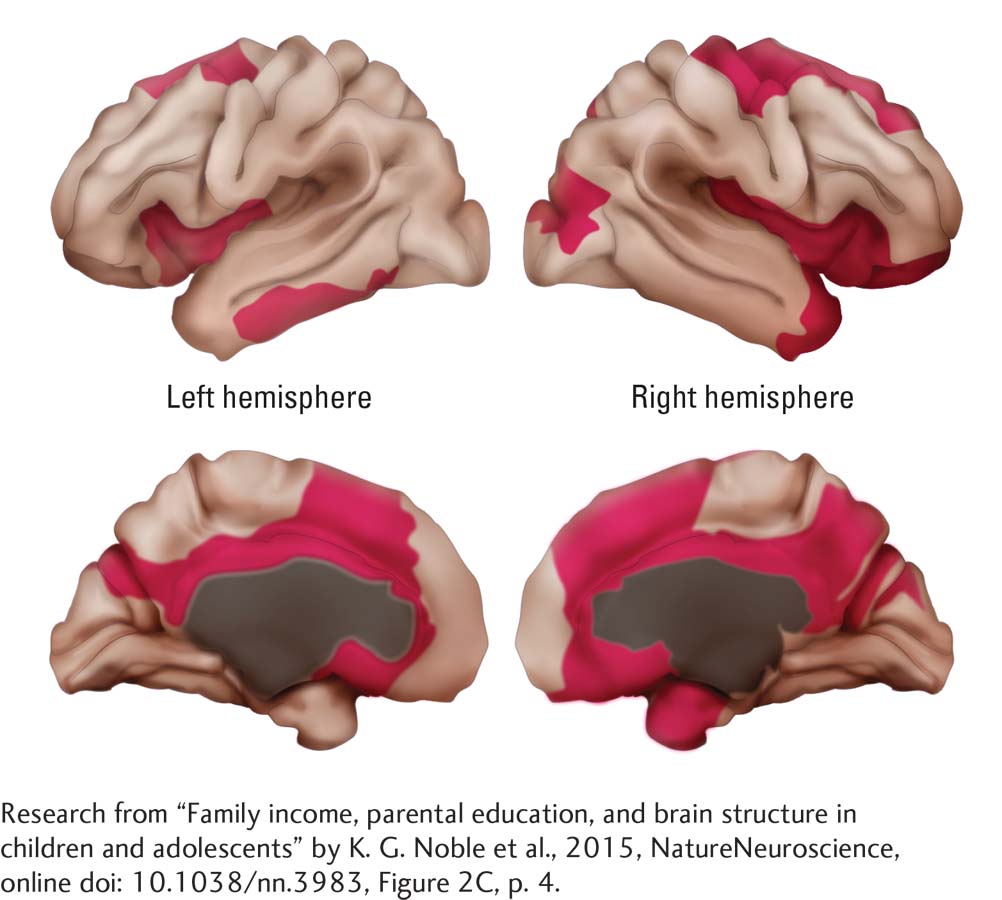Chapter Introduction
How Does the Nervous System Develop and Adapt?
RESEARCH FOCUS 8-
CORRELATING EMERGING BRAIN STRUCTURES WITH EMERGING BEHAVIORS
CORRELATING EMERGING BEHAVIORS WITH NEURAL MATURATION
IDENTIFYING INFLUENCES ON BRAIN AND BEHAVIOR
GROSS DEVELOPMENT OF THE HUMAN NERVOUS SYSTEM
ORIGINS OF NEURONS AND GLIA
NEURONAL GROWTH AND DEVELOPMENT
CLINICAL FOCUS 8-
UNIQUE ASPECTS OF FRONTAL LOBE DEVELOPMENT
GLIAL DEVELOPMENT
MOTOR BEHAVIORS
LANGUAGE DEVELOPMENT
DEVELOPMENT OF PROBLEM-
EXPERIMENT 8-
A CAUTION ABOUT LINKING CORRELATION TO CAUSATION
EXPERIENCE AND CORTICAL ORGANIZATION
RESEARCH FOCUS 8-
EXPERIENCE AND NEURAL CONNECTIVITY
CRITICAL PERIODS FOR EXPERIENCE AND BRAIN DEVELOPMENT
ABNORMAL EXPERIENCE AND BRAIN DEVELOPMENT
HORMONES AND BRAIN DEVELOPMENT
CLINICAL FOCUS 8-
GUT BACTERIA AND BRAIN DEVELOPMENT
INJURY AND BRAIN DEVELOPMENT
DRUGS AND BRAIN DEVELOPMENT
OTHER SOURCES OF ABNORMAL BRAIN DEVELOPMENT
CLINICAL FOCUS 8-
DEVELOPMENTAL DISABILITY

8-1
Linking Socioeconomic Status to Cortical Development
Nobel Prize–
These gaps influence health and prosperity, and they persist throughout life. Childhood SES correlates with cognitive development, language, memory, social and emotional processing, and ultimately with income and health in adulthood. One reason: early experiences related to SES influence children’s cerebral development.
To examine cerebral development, neuroimaging studies (as shown in Figure 8-14) visualize differences in brain development that relate to growing up in under-
Kimberly Noble and her colleagues (2015) used neuroimaging to investigate the relationship between SES and cortical surface area in more than 1000 participants aged 3 to 20. As shown in the illustration, lower family income, independent of race or sex, was associated with decreased cortical surface area in widespread regions of frontal, temporal, and parietal lobes, the regions shown in red.
The investigators also measured participants’ cognitive performance on tests of attention, memory, vocabulary, and reading. The larger the cortical surface area, the better the test outcomes. The negative effects of low SES were especially dramatic at the lower end of the family income spectrum, especially in families with annual incomes less than $30,000.
Low SES is associated with poor nutrition, high stress, and insufficient prenatal and infant care. Following on Heckman’s thesis, investing in children from low-

To see how scientists go about studying the interconnected processes of brain and behavioral development, think about all the architectural parallels between how the brain is constructed and how a house is built. House plans are drawn as blueprints; the plans for a brain are encoded in genes. Architects do not specify every detail in a blueprint, nor do genes include every instruction for brain assembly and wiring.
The brain is too complex to be encoded entirely and precisely in genes. This leaves the fate of billions of brain cells partly undecided, especially in regard to the massive undertaking of forming appropriate connections between cells.
If the structure and fate of each brain cell are not specified in advance, what controls brain development? Many factors are at work, and as with house building, brain development is influenced by the environment in the course of the construction phase and by the quality of the materials. As we saw in Research Focus 8-1, Linking Socioeconomic Status to Cortical Development, living in poverty can compromise children’s brain development.
We can shed light on nervous system development by viewing its architecture from different vantage points—